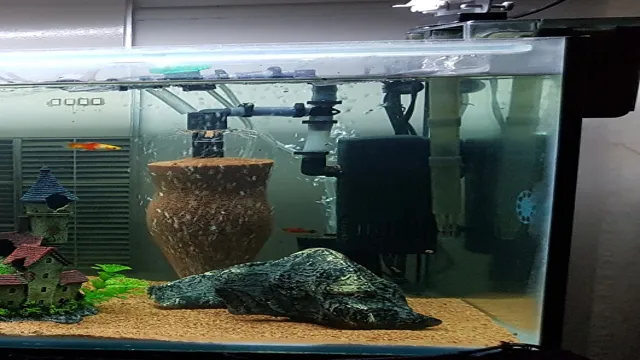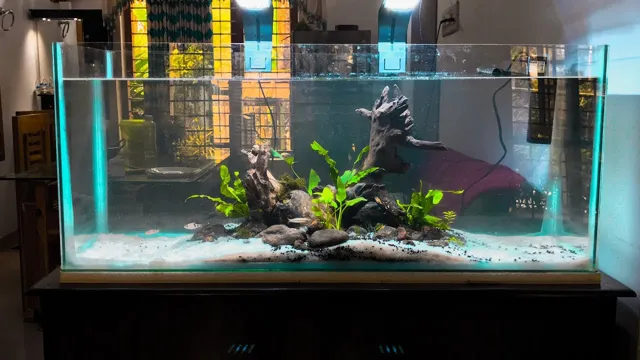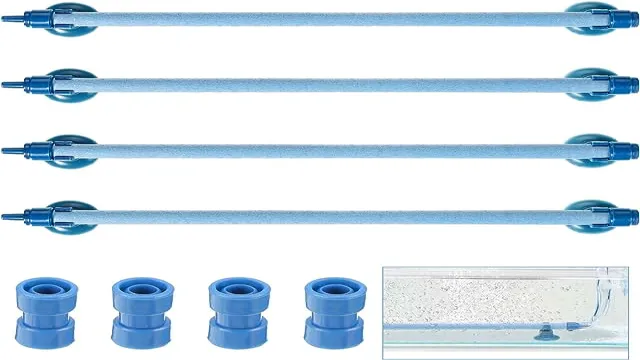If you’re looking to maintain a clean and healthy aquarium, then a fluidized sand filter can be your best bet. Not only does it help in keeping the water crystal clear, but it also aids in efficient biological filtration, making the entire process of aquarium upkeep a lot easier. However, using an aquarium fluidized sand filter can seem like an intimidating task at first, but don’t worry, we’ve got you covered.
In this article, we will guide you through everything you need to know about using an aquarium fluidized sand filter. We’ll cover how it works, the benefits of using it, and how to set it up. We’ll also give you tips on how to maintain it to ensure it functions at its best capacity and prolong its lifespan.
Whether you’re a beginner or an experienced aquarist, you’ll learn something new about this amazing tool that makes aquarium maintenance a breeze. So, grab a cup of coffee, sit back and relax as we take you on a journey through the world of aquarium fluidized sand filters. Let’s dive right in!
What is a fluidized sand filter?
If you’re looking for a way to keep your aquarium water clean and healthy, a fluidized sand filter might be just what you need. This type of filter uses sand particles that are suspended in water and constantly in motion, creating a fluidized bed that traps and removes impurities from the water. The sand particles are lightweight and have a high surface area, allowing them to trap even the smallest particles with ease.
Plus, because the sand is constantly moving, it doesn’t become clogged like traditional filters can. To set up a fluidized sand filter, you’ll need a container filled with sand, a pump to circulate the water, and an intake pipe to draw water into the filter. The pump pushes water up through the sand, creating the fluidized bed and filtering the water as it passes through.
With a fluidized sand filter, you can enjoy clear, healthy aquarium water with minimal effort. So why not give it a try?
Functions of fluidized sand filter
A fluidized sand filter is a type of water treatment system that uses sand particles to filter out contaminants from water. The sand particles are suspended in water and are “fluidized” by a continuous flow of water, creating a sand bed that helps to trap and remove impurities from the water. The fluidized sand filter works by forcing water through this sand bed, which captures unwanted particles and allows clean water to pass through.
This type of filter can be used in a variety of settings, from large-scale water treatment plants to small-scale home filtration systems. The benefits of using a fluidized sand filter include improved water quality, increased efficiency, and reduced maintenance costs. Overall, the fluidized sand filter is an effective and environmentally-friendly method of water treatment that can be tailored to meet the needs of any size system.

Types of fluidized sand filter
A fluidized sand filter is a system utilized to remove unwanted substances from water by passing it through a granular bed of sand or other media. As the name suggests, the sand bed becomes fluid-like during operation, allowing for the efficient filtration of water. There are different types of fluidized sand filters available, each with its unique characteristics and applications.
One of the most popular is the upflow fluidized sand filter, which operates by pumping water from the bottom of the filter and up through the sand bed. Another type is the downflow fluidized sand filter, which operates in the opposite direction. The air lift fluidized sand filter uses an airlift pump to move water and air through the sand bed, and the powerhead fluidized sand filter uses a powerhead pump to circulate water through the sand bed.
Each type of fluidized sand filter is effective in removing a wide range of impurities, making them a popular choice for residential, commercial, and industrial water treatment.
Setting up your fluidized sand filter
If you’re setting up an aquarium, you might want to consider incorporating a fluidized sand filter, which is a type of filter that uses sand to capture debris and waste from your tank. Before setting up this type of filter, be sure to thoroughly rinse and clean the sand to remove any dust or impurities. Next, you’ll need to fill up the filter with the sand, and then add water until it’s completely submerged. (See Also: How to Keep Your Aquarium Warm During Power Outage: Tips and Tricks)
Once you turn on the pump, the water will flow into the bottom of the filter and push the sand up, creating a fluidized bed. This fluidization process increases the surface area of the sand, allowing for more efficient filtration. With its simple setup and effective filtration capabilities, a fluidized sand filter can be a valuable addition to your aquarium setup.
Selecting the right sand for your filter
Fluidized Sand Filter When setting up your fluidized sand filter, selecting the right type of sand is crucial to its effectiveness. Not all sand types are suitable for filtering water, and choosing the wrong one can lead to clogging and poor filtration capabilities. The most common type of sand used for fluidized filters is silica sand, as it has a high surface area and is highly porous.
However, not all silica sands are equal, and it’s important to select one with the right particle size to allow for proper water flow. Additionally, some filters may require a layer of gravel or other materials beneath the sand to prevent clogging and ensure optimal performance. When choosing sand for your fluidized filter, be sure to consider your specific water filtration needs and consult with a professional if unsure.
Investing in the right sand for your filter can save you time and money in the long run, ensuring your water is clean and free of impurities.
Installing and assembling the filter
Setting up a fluidized sand filter can seem like a daunting task, but with the right steps, it can be done with ease. The first step is to select an appropriate location for your filter, ensuring it is stable and level. Next, follow the manufacturer’s instructions to install the filter media, which typically includes a base of gravel, followed by a layer of sand.
Ensure the sand is clean and thoroughly rinsed before pouring it into the filter. Once the media is installed, connect the filter to the pool’s pump system and fill the filter with water. Finally, turn on the pump and check for any leaks.
It is crucial to monitor the filter pressure regularly to ensure that it is operating efficiently. By following these steps and maintaining your fluidized sand filter regularly, you can ensure your pool stays crystal clear all season long. Remember, proper installation and maintenance of your filter will prolong its life, saving you both time and money in the long run.
Connecting the filter to your aquarium
When it comes to setting up a fluidized sand filter for your aquarium, connecting it properly is essential. First, ensure that the filter is turned off and all necessary tools are at arm’s reach. Then, attach the inlet and outlet pipes to the filter’s corresponding fittings.
Secure the pipes tightly using hose clamps to prevent leaks. Next, place the filter media into the chamber according to the manufacturer’s instructions. Once the filter is properly loaded, turn it on and allow it to run for a few hours to ensure proper functionality.
Don’t forget to regularly clean and maintain your filter to ensure optimal water quality for your aquatic pets. By properly connecting your fluidized sand filter, you can ensure a clean and healthy environment for your aquarium pets to thrive.
Maintenance of your fluidized sand filter
If you have an aquarium fluidized sand filter, it’s essential to keep it well-maintained to ensure your aquatic pets stay healthy and happy. One critical step is to perform routine cleanings. Shut off your filter’s power and take out the sand, rinsing it thoroughly to remove any accumulated gunk.
Doing this twice a month will keep your filter functioning correctly. It’s also crucial to change out the sand every few years. When you do, make sure to replace it with the proper grain size recommended for your filter. (See Also: How to Lower Aquarium pH Fast: Solutions and Tips for Optimal Water Quality)
Another good practice is to monitor your filter’s performance regularly. If you notice a decrease in water flow or a change in water quality, it may be time to replace some parts. Properly maintaining your fluidized sand filter will ensure that your aquarium remains a healthy and safe environment for your fish and can keep your filter running efficiently for years to come.
Cleaning the filter regularly
Maintaining your fluidized sand filter is essential if you want it to function properly and efficiently. One of the most important aspects of maintaining your filter is cleaning the filter regularly. Regular cleaning ensures that the filter stays free of debris, which can clog it, leading to poor water quality.
To get the best results, you’ll need to clean the filter at least once a month or more frequently if you have a high fish load. When you’re cleaning the filter, take care not to overdo it, as this could damage the filter media. Be sure to follow the manufacturer’s instructions for cleaning and use only approved cleaning agents.
By keeping your fluidized sand filter clean, you’ll enjoy healthy, clear water in your fish tank.
Replacing the sand as required
Fluidized sand filter Maintaining your fluidized sand filter is crucial in ensuring its optimal performance. One of the key maintenance tasks is replacing the sand as needed. Over time, the sand in the filter can become clogged with debris and lose its effectiveness.
This can lead to poor water quality and reduced filtration capabilities. To prevent this, it’s important to check the sand regularly and replace it as needed. This is typically done every 3-5 years, but may vary based on usage and water conditions.
When replacing the sand, be sure to use a high-quality, specifically designed filter sand to ensure the best results. By properly maintaining your fluidized sand filter, you can ensure clean, clear water and avoid costly repairs and replacements down the line.
Benefits of using a fluidized sand filter
If you’re looking for an efficient filtration system for your aquarium, consider using a fluidized sand filter. This type of filter offers many benefits, including improved water clarity and reduced build-up of harmful substances. A fluidized sand filter works by circulating water through a bed of sand particles, which creates a constantly moving bed of sand.
As water passes through the sand, debris and waste particles are trapped, leaving behind clean water for your fish or plants to thrive in. Another benefit of using a fluidized sand filter is the ability to support beneficial bacteria growth. These bacteria help break down harmful substances like ammonia and nitrites, which can be deadly for aquatic life at high levels.
Plus, maintenance is relatively easy with a fluidized sand filter, as you only need to replace the sand periodically. Consider adding a fluidized sand filter to your aquarium for a cleaner, healthier environment for your aquatic pets.
Conclusion
In conclusion, setting up an aquarium fluidized sand filter may seem daunting at first, but with a little patience and the right equipment, it’s a remarkably simple process. Not only does it effectively filter out debris and waste from your aquarium, but it can also provide a fun and mesmerizing visual experience for both you and your aquatic friends. Plus, with the added benefit of aeration, your tank will be the envy of all the other fish on the block. (See Also: How to Get Rid of Pond Snails in My Aquarium: Tips and Tricks)
So don’t be afraid to take the plunge and try out a fluidized sand filter – you and your fish will be glad you did!”
FAQs
What is a fluidized sand filter for aquariums?
A fluidized sand filter is a type of filter that uses sand as the primary filter medium, and works by circulating water through the sand to remove debris and impurities.
How does a fluidized sand filter work?
A fluidized sand filter works by using a pump to circulate water through a column of sand, which causes the sand to become suspended in the water. As the water flows through the sand, debris and impurities are trapped and removed.
What are the benefits of using a fluidized sand filter in an aquarium?
Some benefits of using a fluidized sand filter in an aquarium include improved water quality, reduced maintenance, and increased oxygenation of the water.
How often should a fluidized sand filter be cleaned?
The frequency with which a fluidized sand filter should be cleaned depends on a variety of factors, including the size of the filter and the amount of waste produced by the aquarium inhabitants. Generally, it is recommended to clean the filter once every 2-4 weeks.
Can a fluidized sand filter be used in a saltwater aquarium?
Yes, a fluidized sand filter can be used in a saltwater aquarium. However, care must be taken to ensure that the sand used in the filter is appropriate for use in a saltwater environment.
Are fluidized sand filters expensive?
The cost of a fluidized sand filter can vary depending on the size and brand of the filter, but they are generally considered to be a moderately expensive type of aquarium filter.
How do I set up a fluidized sand filter in my aquarium?
To set up a fluidized sand filter in your aquarium, you will need to install the pump, connect the filter to the aquarium, and fill the filter with sand. It is important to follow the manufacturer’s instructions carefully to ensure proper installation and operation.







